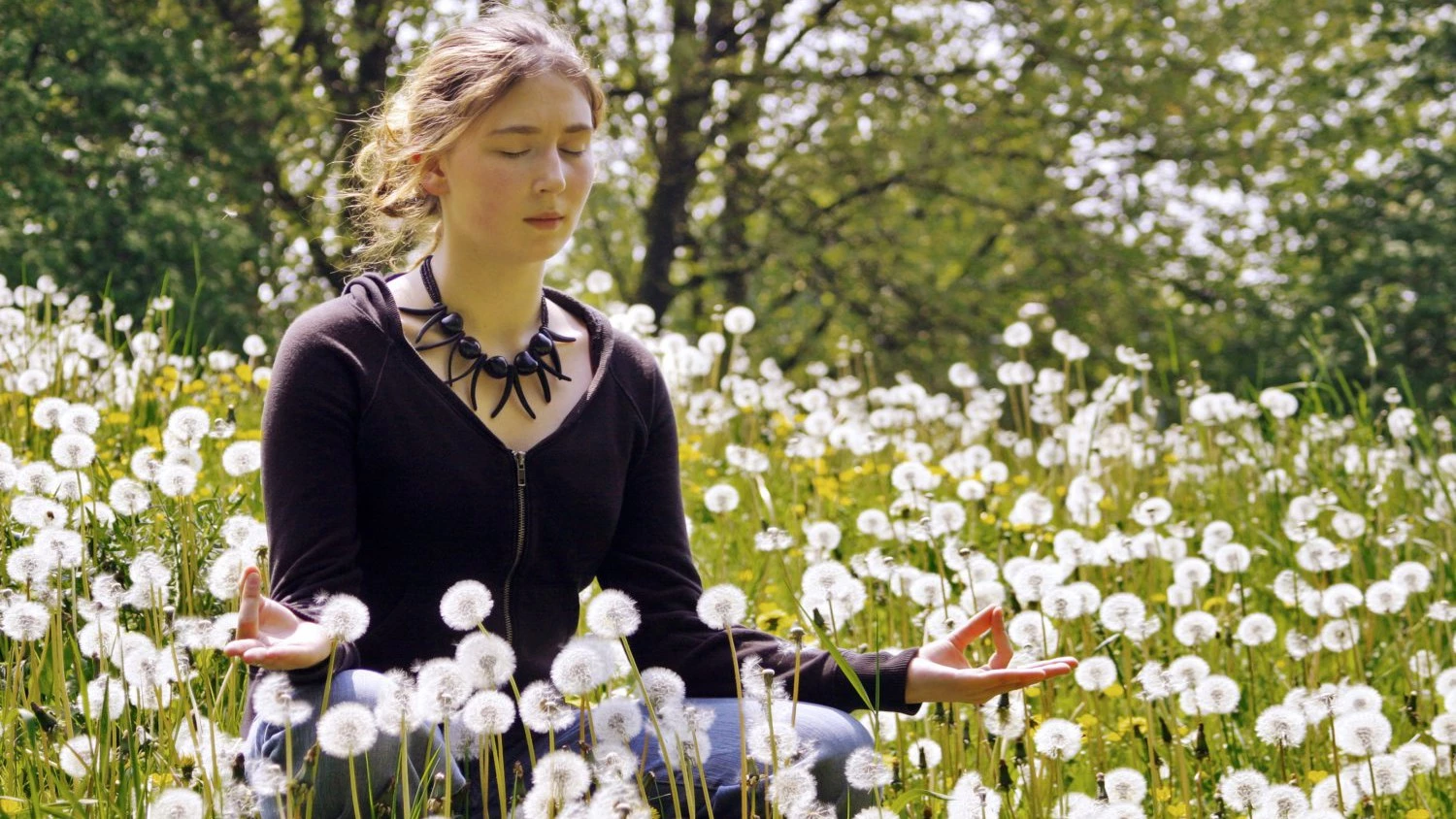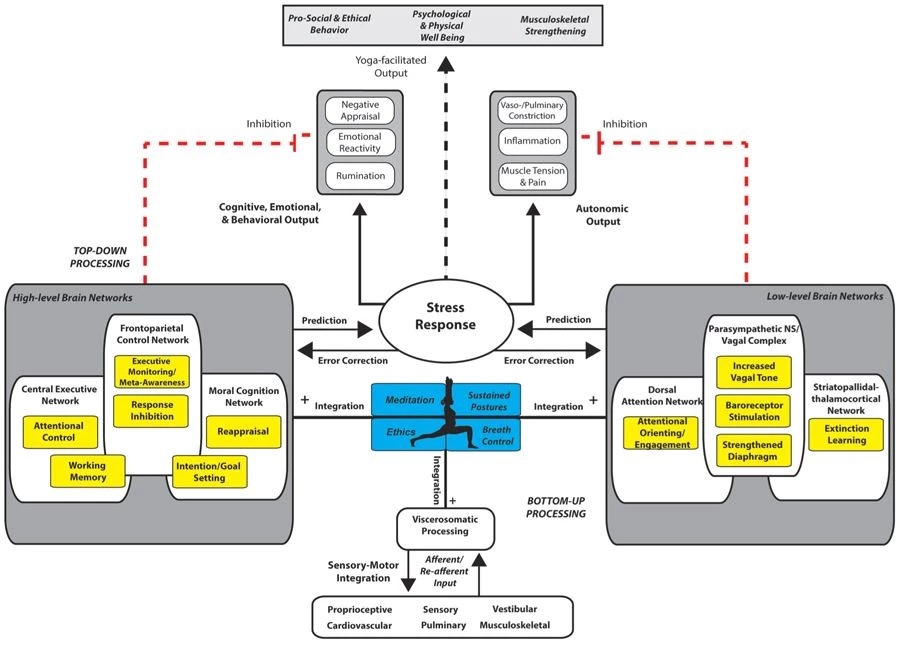The Neuroscience of How Yoga Helps Your Mental Health – Part 1 & 2

I’ve been thinking, reading and teaching about how yoga influences neurobiology for a number of years.
So when one of my students passed along a recently published article proposing a comprehensive model for the self-regulatory mechanisms of yoga, I got all dysregulated – increased heart rate, dilated pupils, sweaty palms, insomnia – it’s too exciting!
It’s going to take me a while to break this stuff down, so I’m going to write several short blogs to try to cover the main themes.
One of the things I most love about this is that it goes beyond some of the previous models (that only look at postures or pranayama) and defines yoga as ethics, meditation, postures and breathing regulation. That’s huge. When they start adding bhakti to the models I’ll have even more to celebrate. At this moment, I’ll happily take something more holistic than postures.
I want to start with some perspective.
As tools of measurement have gotten more powerful, specifically functional MRIs, scientists have been able to measure brain changes associated with practice. The kind of jump starter was Richard Davidson’s famous research at the University of Wisconsin in the early 2000s – remember, the cover of Time with the meditating monk with electrodes on his shaved monk head? People who meditate, Davidson’s research found, have thicker pre-frontal cortices. The implication is more front brain = better capacity to inhibit (your behavior, thoughts, actions). Good for mental health and health in general.
Lots of other research followed including Sarah Lazar’s work – she took non-meditators, taught them some techniques and after two weeks – Voila! Brain changes. So it’s not just 40 hour a week meditation professionals who benefit.
Then Rick Hanson (who’s been dubbed “The Mr. Roger’s of Neuroscience”) made it a lot easier for us lay people to understand meditations effect on the 3 pound lump of tofu inside our heads. People like Bessel van der Kolk, Stephen Porges, Dan Siegel (and I would venture to add Rupert Sheldrake to this list although many label his fascinating research grossly “unscientific”), have expanded the definition of the brain and mind beyond the cranium.
Tim Gard in Boston along with a team of researchers from all over the place, have put together a model of how yoga helps us self-regulate. Yes, a model! I know, it’s so exciting, I can’t stand it.
Here’s a picture of it:

Part 2:
And as my excitement induced insomnia subsides, I want to break this article down in separate blogs, so you can really understand a few key concepts and the profound implications for yoga on mental health. I want to frame this for those of you who want to help improve the very scary mental health situation we are facing as a society and globally (did you know the World Health Organization ranked depression fourth among the 10 leading causes of the global burden of disease? But that is another blog).
Today I want to go into just one basic concept about how we self-regulate, (actually half of it): Top Down and Bottom Up.
Top Down essentially means using the higher functions of the brain to help self-regulate. A lot of this originates in the prefrontal cortex. The Frontoparietal Control Network (FPCN) is the network in the brain that creates a sense of self-awareness, figures out what’s going on, and inhibits inappropriate responses.
Let’s say a recently showered mom finds her suspiciously chewing toddler sitting in a pile of crayon and notices her freshly painted walls have just been artistically re-expressed. Her midbrain might want to scream at him or worse. But her FPCN appraises the situation, remembers that he is two, cleans out his mouth, takes a picture of the wall, redirects him to more appropriate artistic endeavors, and searches for the advil on top of the fridge. That process is top down self-regulation. (Although interestingly you can’t split it up entirely. The process of using the body, cleaning things up, taking pictures and even taking a pill are all using bottom up self-regulation as well, but we’ll get to that later.)
An associated network, the Central Executive Network, supports your attention and uses working memory to help you behave in a way that’s goal directed – and self-correct when you screw up. So here I am writing this blog, but occasionally I have to go to the web and check something out in an article or Wikipedia. And while I’m there, I’ll just swing over to Facebook and, Oh! that’s such a cute video of a cat swatting at an alligator over a chicken leg! Wait a minute, what was I doing? Oh yeah, I gotta finish that blog. You get the picture. Social media loves to challenge the CEN’s work.
Finally the Moral Cognition Network supports motivation and intention setting and does good things for others and yourself. Sounds like the yamas and niyamas right? Morality is the foundation of yoga for a reason – there’s lots of research that links morality to better mental and physical health outcomes. It’s a powerful tool for self-regulation.
So this is a summary of the top down processes that help us self-regulate. In the next blog I’ll cover bottom up self-regulation. And then (it’s coming!) how yoga influences these networks in really amazing, positive ways.
To contine reading Part 3 of Kaoverii’s blog see here.
Reprinted with permission from subtleyoga.com
 Kristine Kaoverii Weber is the founder of Subtle Yoga in Ashville and Charlotte, North Carolina. She has been a student of yoga since she was introduced to it in sixth grade. Kaoverii has been teaching yoga for more than twenty years. And her work these days focuses on providing yoga teacher trainings on the 200- hour and 500-hour level. Kaoverii is the director of Sarva Health, an organization which provides holistic yoga-based trainings to enhance community health infrastructure. In particular, Kaoverii developed the first RYT 200-hour training program specifically for mental health and substance abuse treatment professionals to be offered by a major continuing education institution. She is a frequent contributor to national magazines and the author of Healing Self Massage which shows how to use massage as a complement to yoga practice to relieve stress, neck and back pain, insomnia, and anxiety.
Kristine Kaoverii Weber is the founder of Subtle Yoga in Ashville and Charlotte, North Carolina. She has been a student of yoga since she was introduced to it in sixth grade. Kaoverii has been teaching yoga for more than twenty years. And her work these days focuses on providing yoga teacher trainings on the 200- hour and 500-hour level. Kaoverii is the director of Sarva Health, an organization which provides holistic yoga-based trainings to enhance community health infrastructure. In particular, Kaoverii developed the first RYT 200-hour training program specifically for mental health and substance abuse treatment professionals to be offered by a major continuing education institution. She is a frequent contributor to national magazines and the author of Healing Self Massage which shows how to use massage as a complement to yoga practice to relieve stress, neck and back pain, insomnia, and anxiety.



